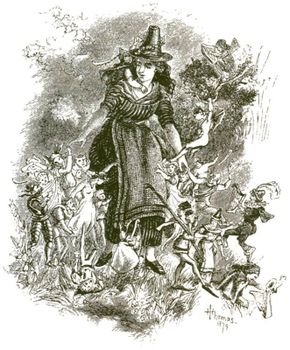Old Alien Sightings
Still other accounts of UFOs are rooted in culture, perhaps the result of visions or hallucinations. Just before sunset on April 16, 1651, two women in rural England supposedly witnessed a battle between armies. At the conclusion of the battle there appeared, according to a contemporary account, blue angels "about the bigness of a capon, having faces (as they thought) like owls." Neither wars nor angels in the sky were uncommon "sights" from Roman times to the early modern era. In A.D. 793 the Anglo-Saxon Chronicle reported "fiery dragons . . . flying in the air," and almost a thousand years later, in 1762, a "twisting serpent" supposedly cavorted over Devonshire.
Along with this aerial activity were speculations and reports in popular lore of humanoid creatures dwelling in caves, bodies of water, or invisible realms. These humanoids varied widely in appearance; height alone ranged from a few inches to many feet. They possessed supernatural powers and sometimes kidnapped adults and children. These creatures, unpredictable and easily offended, were so feared that it was considered unwise to even speak their name. They were believed to be, according to one 17th-century account, "of a middle nature between man and angels." To see these humanoids, a person usually had to be in "fai-erie," meaning a state of enchantment. The traditional Anglo-Saxon name for these entities was "elves," now supplanted by "fairies."
Advertisement
Since 1947 some writers, notably Jacques Vallée in "Passport to Magonia," have tried to link fairies to modern UFO encounters with humanoids. But this connection is speculative at best. The reader must be willing to assume that fairies were "real" and then overlook many dissimilarities between fairies and UFO humanoids. Fairy beliefs really have more in common with ghosts, monsters, and fabulous beasts than modern accounts of encounters with UFOs.
Other writers, such as Desmond Leslie, George Hunt Williamson, M. K. Jessup, Yonah Fortner, and Brinsley le Poer Trench, also tried to find evidence of aliens visiting Earth before 1800, but their arguments are weak. Supposedly, extraterrestrials had been here for many thousands of years, leaving traces of their presence in legends and Biblical chapters as well as in such archaeological monuments as Stonehenge, the Great Pyramid, and Peru's Nazca plains. These ideas were picked up and elaborated upon in the late 1960s and 1970s by a new school of writers (most famously Erich von Daniken of Switzerland), referring to "ancient astronauts."
Serious UFO researchers -- not to mention astronomers, archaeologists, and historians -- rejected these speculations, which in their view grew out of ignorance and distortion. Critics charged that there was no evidence to support so radical a revision of history and that such speculations deliberately slighted the role of human intelligence. Still, von Daniken's books had an enormous impact on impressionable readers.
